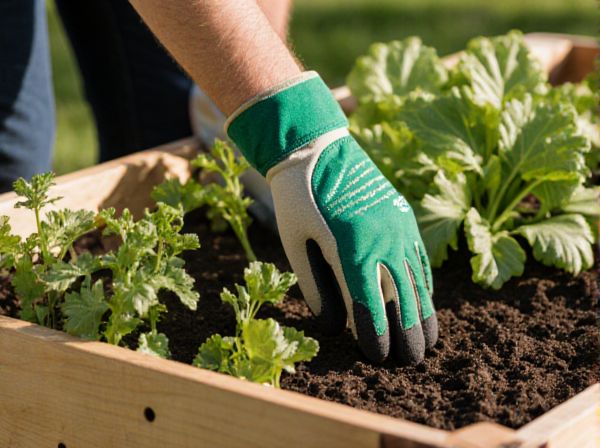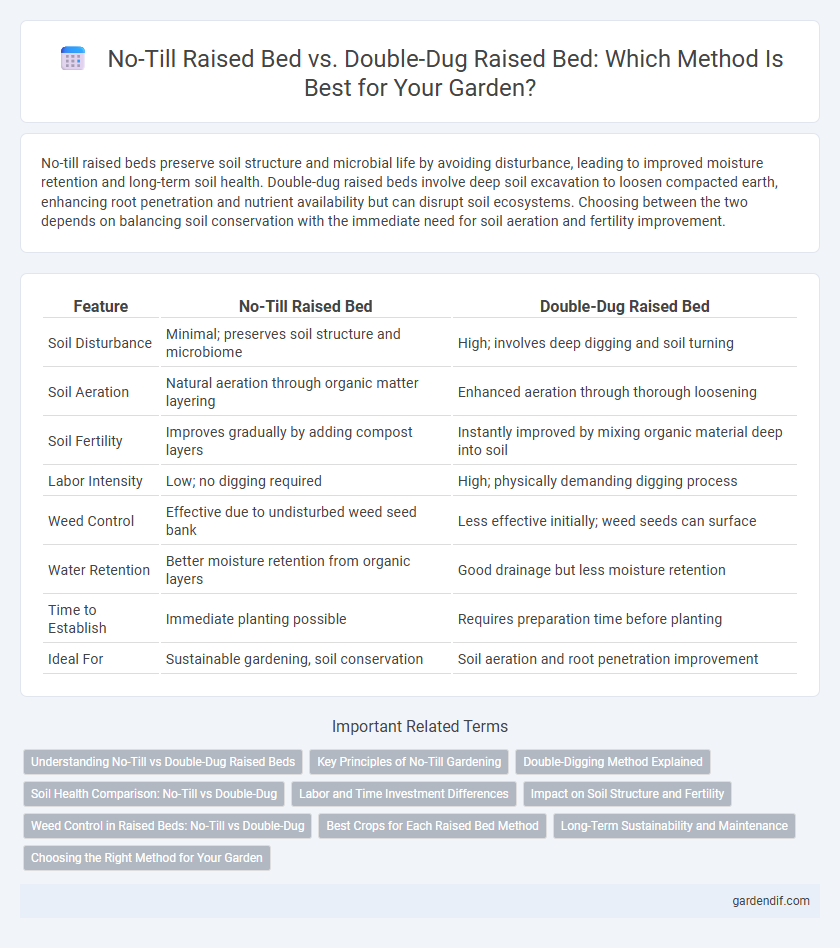
No-Till Raised Bed vs Double-Dug Raised Bed Illustration
No-till raised beds preserve soil structure and microbial life by avoiding disturbance, leading to improved moisture retention and long-term soil health. Double-dug raised beds involve deep soil excavation to loosen compacted earth, enhancing root penetration and nutrient availability but can disrupt soil ecosystems. Choosing between the two depends on balancing soil conservation with the immediate need for soil aeration and fertility improvement.
Table of Comparison
| Feature | No-Till Raised Bed | Double-Dug Raised Bed |
|---|---|---|
| Soil Disturbance | Minimal; preserves soil structure and microbiome | High; involves deep digging and soil turning |
| Soil Aeration | Natural aeration through organic matter layering | Enhanced aeration through thorough loosening |
| Soil Fertility | Improves gradually by adding compost layers | Instantly improved by mixing organic material deep into soil |
| Labor Intensity | Low; no digging required | High; physically demanding digging process |
| Weed Control | Effective due to undisturbed weed seed bank | Less effective initially; weed seeds can surface |
| Water Retention | Better moisture retention from organic layers | Good drainage but less moisture retention |
| Time to Establish | Immediate planting possible | Requires preparation time before planting |
| Ideal For | Sustainable gardening, soil conservation | Soil aeration and root penetration improvement |
Understanding No-Till vs Double-Dug Raised Beds
No-till raised beds preserve soil structure by minimizing disturbance, enhancing microbial activity and organic matter retention for sustained plant health. Double-dug raised beds involve deep soil loosening by manually turning over two layers, improving aeration and root penetration but potentially disrupting beneficial soil organisms. Choosing between methods depends on balancing soil conservation with soil aeration needs to optimize crop growth.
Key Principles of No-Till Gardening
No-till raised beds maintain soil structure and microbial life by avoiding disturbance, preserving beneficial fungi and earthworms essential for nutrient cycling. This method enhances moisture retention and reduces erosion compared to double-dug beds where soil is regularly turned and aerated. Key principles include minimal soil disruption, continuous organic mulch cover, and diverse crop rotation to foster healthy, resilient soil ecosystems.
Double-Digging Method Explained
The double-digging method involves manually loosening two layers of soil in a raised bed to improve aeration, drainage, and root penetration, which enhances plant growth compared to no-till beds. This technique requires digging trenches, removing subsoil, and mixing organic matter into the soil, creating a deeply cultivated bed ideal for root crops and nutrient-demanding plants. While more labor-intensive than no-till raised beds, double-digging promotes long-term soil fertility and structure by facilitating microbial activity and better nutrient cycling.
Soil Health Comparison: No-Till vs Double-Dug
No-till raised beds preserve soil structure by minimizing disturbance, promoting microbial diversity, and enhancing organic matter retention, which leads to improved soil health and nutrient cycling. Double-dug raised beds, while aerating the soil and loosening compaction, can disrupt soil microbial communities and accelerate decomposition of organic matter if done frequently. Maintaining soil integrity with no-till practices supports long-term fertility, whereas double-digging may require more frequent amendments to sustain optimal soil conditions.
Labor and Time Investment Differences
No-till raised beds significantly reduce labor and time investment by eliminating soil disturbance, allowing for faster planting and less physical effort compared to double-dug raised beds, which require intensive manual digging to aerate and loosen soil deeply. The no-till method preserves soil structure and microbial life, leading to long-term soil health benefits with minimal upkeep, whereas double digging demands substantial initial labor and periodic re-digging to maintain optimal soil conditions. Gardeners prioritizing efficiency and sustainability often prefer no-till raised beds to maximize productivity while minimizing physical strain and time commitments.
Impact on Soil Structure and Fertility
No-till raised beds preserve soil structure by minimizing disturbance, maintaining beneficial microbial activity and organic matter, which enhances long-term soil fertility. In contrast, double-dug raised beds involve deep turning of the soil, which temporarily aerates and loosens the soil but can disrupt soil aggregates and microbial communities, potentially reducing stability over time. Choosing no-till methods supports sustainable soil health by fostering natural nutrient cycling and reducing erosion risks.
Weed Control in Raised Beds: No-Till vs Double-Dug
No-till raised beds minimize soil disturbance, reducing weed seed germination by leaving weed seeds buried and intact, which limits their emergence over time. Double-dug raised beds, while improving soil aeration and root penetration, often bring dormant weed seeds to the surface, increasing the likelihood of weed growth. Effective weed control in raised beds depends on balancing soil health benefits with the propensity for weed seed activation inherent to each preparation method.
Best Crops for Each Raised Bed Method
No-till raised beds excel in growing leafy greens, root vegetables like carrots and beets, and legumes because they maintain soil structure and beneficial microorganisms. Double-dug raised beds are ideal for crops requiring deep root penetration such as potatoes, tomatoes, and other fruiting plants due to enhanced soil aeration and nutrient availability. Selecting the right bed method based on crop root depth and soil disturbance preferences maximizes yield and plant health.
Long-Term Sustainability and Maintenance
No-till raised beds enhance long-term soil health by preserving natural microbial ecosystems and preventing erosion, minimizing the need for frequent soil disturbance and replenishment. Double-dug raised beds provide deep aeration and immediate nutrient access but require more intensive labor and can accelerate organic matter depletion over time. Prioritizing no-till methods supports sustainable soil structure and reduces maintenance demands, making it ideal for perennial planting systems.
Choosing the Right Method for Your Garden
Choosing between a No-Till Raised Bed and a Double-Dug Raised Bed depends on your soil health goals and maintenance preferences. No-Till beds preserve soil structure and promote beneficial microorganisms by minimizing disturbance, ideal for sustainable gardening and carbon sequestration. Double-Dug beds enhance aeration and root penetration through deeper soil turning but require more labor and can disrupt soil ecosystems.
No-Till Raised Bed vs Double-Dug Raised Bed Infographic

 gardendif.com
gardendif.com